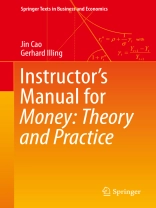This instructor’s manual complements the textbook Money: Theory and Practice which provides an introduction to modern monetary economics for advanced undergraduates, highlighting the lessons learned from the recent financial crisis. The manual provides teachers with exercises and examples that reflect both the core New Keynesian model and recent advances, taking into account financial frictions, and discusses recent research on an intuitive level based on simple static and two-period models.
Daftar Isi
Part I: Money and Equilibrium in the Long Run.- Long Run Growth: The Basic Framework.- Money and Long Run Growth.- Interaction Between Monetary and Fiscal Policy: Active and Passive Monetary Regimes.-
Part II:
Monetary Policy in the Short Run.- New Keynesian Macroeconomics.- Optimal Monetary Policy.- Monetary Policy Under Uncertainty.- The Liquidity Trap:
Limits for Monetary Policy at the Effective Lower Bound.-
Part III :
Unconventional Monetary Policy, Financial Frictions and Crises.- Monetary Policy in Practice.- Financial Frictions and Monetary Policy.- Monetary Policy and Financial Stability.-
Appendix: Dynamic Optimization Using Lagrangian and Hamiltonian Methods.- Dynamic Programming.
Tentang Penulis
Jin Cao is a research economist in Norges Bank, the Central Bank of Norway. He holds a Ph D in economics from Ludwig Maximilians University of Munich, Germany. His research focuses on banking and finance, monetary economics, economics and institutions.
Gerhard Illing holds the chair in macroeconomics at the Ludwig Maximilian University in Munich, Germany. Previously, he was Professor at the University of Bamberg, Germany from 1993 -1995 and at the Goethe University Frankfurt, Germany from 1995 – 2001. His research focuses on monetary theory, financial stability, systemic risk and lender of last resort policy. He has written several books on macroeconomics, monetary theory and game theory.












